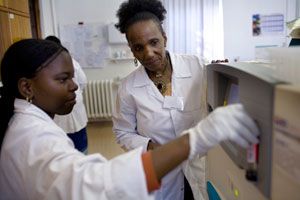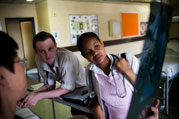Survey of African medical schools identifies needs
November/December 2010 | Volume 9, Issue 6
The critical shortage of physicians in sub-Saharan Africa is the result of the low number of graduates - and high rate of their immigration to other countries - combined with faculty shortages and inadequate financial support, according to a survey of the region’s medical schools.

Photo by David Rochkind
The Sub-Saharan African Medical School Study details
the challenges, innovations and emerging trends in the
region’s medical education.
The two-year comprehensive study examined the challenges, innovations and emerging trends in African medical education and was led by Drs. Fitzhugh Mullan, Seble Frehywot and colleagues at George Washington University, in collaboration with an advisory committee of the region’s leading academics. The study’s findings and recommendations were recently published in The Lancet.
"Although national and international interest with respect to strategic investment in medical education in sub-Saharan Africa has been growing, little is known about the status of medical schools or trends within medical education across the continent," according to the study. Any attempts to improve health in these countries "should consider options to increase both the productivity of medical schools and the retention of their graduates within their countries," the authors suggest.
Proposed recommendations to strengthen medical education in Sub-Saharan Africa
- Launch campaigns to develop the capacity of medical school faculties; including recruitment, training, and retention
- Increase investment in medical education infrastructure
- Build structures to promote inter-ministerial collaboration for medical education
- Fund research and research training at medical schools
- Promote community orientated education based on principles of primary health care
- Establish national and regional postgraduate medical education programs to promote training, excellence and retention
- Establish national or regional bodies that are responsible for accreditation and quality assurance of medical education
- Increase donor investment in medical education aligned with national health needs
- Recognize and review the growing role of private institutions in medical education
- Revitalize the African Medical Schools Association
Based on responses from more than 100 of the region’s 168 medical schools, the survey team noted faculty and curricular issues were the most commonly identified as key to improving the quality of graduates, while infrastructure concerns were the most often cited barriers to increasing the quantity. Inadequate funding was mentioned in connection to both.
Nearly every medical school visited for the study suffered some degree of faculty shortage, with low salaries, limited career options, heavy teaching loads, and lack of support staff and equipment reported as the main barriers to faculty retention. Geographical distribution of physicians was also identified as a common concern, particularly in rural areas. Though the survey showed this is less of an issue for countries that require graduates complete compulsory service.
The study found infrastructure deficiencies are "ubiquitous and restricting." Daily power outages, insufficient number of computers, low bandwidth internet access and inadequate student housing were among the resource issues reported.
Lack of coordination among government agencies is another common problem, the survey found. "In many countries, coordinated planning for budgets, priorities and outcomes between ministries of health and education is poor, which contributes to inappropriate curricula and the graduation of doctors who cannot find employment in the country."

Photo by David Rochkind
Some survey respondents report
maintaining an active research
portfolio aids staff recruitment and
retention at African medical schools.
While respondents say the presence of an active research portfolio aids staff recruitment and retention, the study found less than 10 percent of the region’s medical faculty are involved in sponsored research. This was particularly a problem at newer, smaller schools with younger faculty who lack the training and mentorship to successfully compete for research grants.
On a positive note, the authors discovered "impressive curricular innovations" at many schools, including community-based education, problem-based learning and multidisciplinary team-based learning.
The study and its recommendations are intended to provide a catalyst for further innovations and investment in medical education in sub-Saharan Africa, the report concludes. "This action, in turn, should help produce a more robust workforce with the aim of improved health in Africa." The Medical Education Partnership Initiative (MEPI), managed by Fogarty and the Health Resources and Services Administration, will address many of these issues, as described recently in Science.
More Information
Medical schools in sub-Saharan Africa, The Lancet, 11 Nov. 2010, online.
Developing Health Workforce Capacity in Africa, Science, 3 Dec. 2010, pgs. 1324-5.
To view Adobe PDF files,
download current, free accessible plug-ins from Adobe's website.
Related Fogarty Programs
Related World Regions / Countries